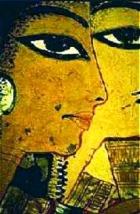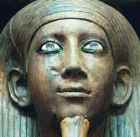Slaves in the Bible
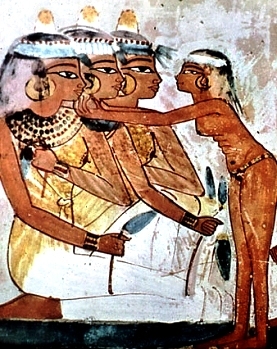
Egyptian slave girl
Be careful when you read the word ‘slave’ in the Bible. It can mean different things:
- a servant as in 2 Samuel verse 9 (see Note below) where a man called Ziba is the servant of King Saul
- a bondsman or woman, such as the ones mentioned in verse 10 below
- a courtier or subject of the king, where the word is used in the same way as in the phrase ‘your humble servant’ (verse 11 below)
- a slave, someone held in bondage like Hagar, Sarah’s slave girl (see her story below).
A slave was property, a possession. This is clear in the list of Commandments in Exodus 20:17, where slaves are lumped in with cattle.
The slave had virtually no rights: he could be beaten until nearly dead, but it was forbidden for his master to actually kill him (Exodus 21:21). If a slave girl was criminally assaulted, compensation was paid to her owner, not her.
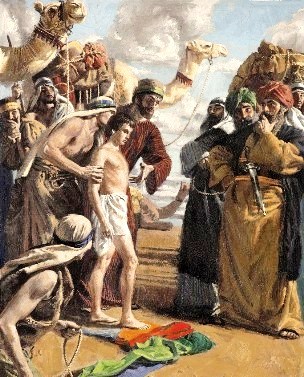
Slaves: Joseph sold as a slave
A father could sell his daughter as a concubine. The only condition of the sale was that she could not be sold on to another tribe. This happened to Hagar, the Egyptian slave girl of Sarah, wife of Abraham.
Note: different uses for the same word
9 Then the king called Ziba, Saul’s servant, and said to him, “All that belonged to Saul and to all his house I have given to your master’s son. 10 And you and your sons and your servants shall till the land for him, and shall bring in the produce, that your master’s son may have bread to eat; but Mephib’osheth your master’s son shall always eat at my table.” Now Ziba had fifteen sons and twenty servants. 11 Then Ziba said to the king, “According to all that my lord the king commands his servant, so will your servant do.” So Mephib’osheth ate at David’s table, like one of the king’s sons.
Hagar’s story
Hagar was the Egyptian slave of Sarah, wife of Abraham. She was probably acquired when Abraham and Sarah were in Egypt. When Sarah could not conceive a child, she gave Hagar to Abraham as a concubine, so that the girl might conceive a child that would legally belong to Sarah, and be named as Abraham’s successor.
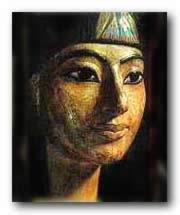
Moulded clay statue of an Egyptian woman
A great deal of holier-than-thou nonsense is written about the injustice of this, but the truth is that Hagar would have leapt at the chance to improve her social status from slave to concubine, with the chance of becoming mother of the next leader of the tribe.
Hagar became pregnant, but it is made clear that Sarah was still the Queen Bee of the tribe. Hagar still belonged to her, even though she was the mother of Abraham’s child. It seems that female slaves were under the legal jurisdiction of the Alpha Female of the tribe, and were not considered the property of the male tribal leader. See Genesis 16, 21.
For more on Hagar, see Bible women: Hagar
Joseph’s story
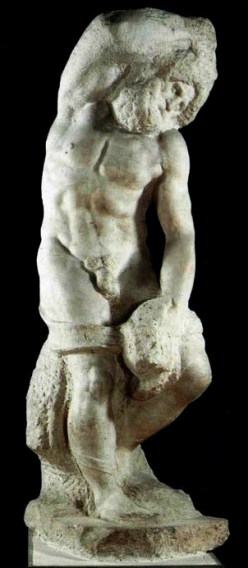
Slaves: Michelangelo’s unfinished ‘Bearded Slave’ captures a slave’s sense of imprisonment, of being trapped
File written by Adobe Photoshop? 5.0
Joseph was sold into slavery by his brothers, who hated him. He was taken to Egypt where he was auctioned in an open market to the highest bidder. His future looked black, but the subsequent story shows how a clever and skilled slave could rise in the world – Joseph quickly becomes the trusted overseer of large estates belonging to his Egyptian master, Potiphar.
However, the story also shows how vulnerable a slave was. Potiphar’s wife mades sexual advances to him, expecting that she, as his owner, could expect him to respond in the same way as a slave girl might submit to her master.
When Joseph rejected her, she was humiliated and outraged, since his refusal contradicted what she saw as normal practice. She accused him of attempted rape. Now the slave’s vulnerability became clear: despite his ability and faithful service to Potiphar, Joseph was immediately cast into prison, without trial, where he languished for some years. See Genesis 37-50.
Onesimus’ story
The Letter of Paul to Philemon describes the slave Onesimus, possibly a runaway, and tells us something about the way that slaves were regarded in New Testament times. He is with Paul, not only serving him but newly converted to the Good News.
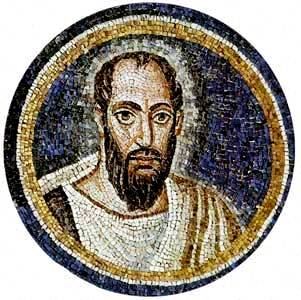
Stone mosaic showing image of a bearded St Paul
Paul seems to look on Onesimus almost as his own child, and wants the slave to continue in his service. Nevertheless, Paul knows the legal implications of this, and that he is obliged to send him back to his master, Philemon. He wonders whether Onesimus has wronged his former master? Or perhaps stolen something from him?
If this is so, Paul has to tread carefully. He speaks in a deferential way to Philemon, diplomatically asking for the slave to be released.
At the end of the letter, we get another clue to the situation – Paul is about to visit Philemon, probably bringing Onesimus with him. When Paul arrives, can he hope that Philemon will give him Onesimus as a gift?
(See the Letter to the Colossians 4:9; Philemon)
Rules for the treatment of slaves

Still from the movie ‘Ben Hur’,
showing the hero as a galley slave
Popular modern images of slaves (as in the film Ben Hur) emphasize the worst-case scenarios, ignoring the millions of slaves who in many ways resembled modern workers, tied to their workplace much as ancient slaves were
Slavery was accepted as a normal part of life in the ancient world. People often lived at close quarters with their slaves, and saw them as lower-status, expendable family members.
How did people end up as slaves? In Hebrew society, people often fell into debt. If they could not pay, they might have to sell themselves as a slave, though usually for a limited period. Even then, they would be released on payment of the debt. Children could be sold by their parents, in payment for a debt.
If debt was the reason for a man becoming a slave, he had a special status, and had to be treated as a hired servant. When, every seven years, the Year of Jubilee came, all such slaves had to be given their freedom. But for a girl it was different: she had to stay with her owner.
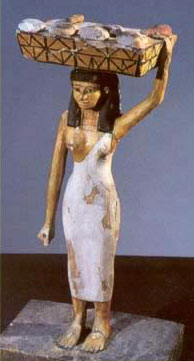
Egyptian woman carrying basket with loaves of bread
There were no prisons as there are in the modern world, and a thief was often punished by being made the slave of the person from whom he had stolen. This meant he had to work for them until he had paid for the damage he had caused or the goods he had stolen.
20 “When a man strikes his slave, male or female, with a rod and the slave dies under his hand, he shall be punished. 21 But if the slave survives a day or two, he is not to be punished; for the slave is his money.”
There were other types of slaves as well: foreigners who had been captured in war or a raid, and were bought in the open market or allocated to soldiers of the victorious army. The Law of Moses allowed Hebrews to own slaves provided they were taken as captives from the surrounding countries, and were not Hebrews.
There were also ‘houseborn’ slaves, children who were born to a woman already a slave – her child automatically belonged to her master.
Slaves did many types of work. If they had ability and luck they might be physicians or accountants or business managers. Many slaves achieved wealth and high status; others were forced to work at less pleasant tasks, for example in mines or quarries.
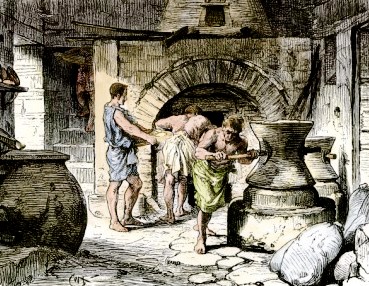
Slaves working in a bakery,
reconstruction from ancient Pompeii
It was the duty of the owner of the slave to look after his property well, and there were strict laws about the treatment of slaves (Exodus 21, Genesis 17:12-12). The owner of a slave was allowed to beat the slave as long as no serious injury was done. If a slave died after being beaten, the owner was punished. A debt slave could not be made to work for a master for longer than six years. Jewish people never allowed themselves to forget that once they too had been slaves in Egypt, and God had saved them, so it was a case of ‘there but for the grace of God go I….’
Many slaves were captives of war, or their children. Some were from slave traders. Poverty or debt might force the freeborn to sell themselves as slaves.
According to Nehemiah 7:66 ff, the Jewish people after the Exile numbered 42,360 with 7,337 slaves, a proportion of about 1 slave to 6 freemen.
The Ten Commandments granted slaves at least one rest day a week and they took part with the rest of the household in religious feasts. Before being allowed to take the Passover, however, the slave had to be circumcised. Kidnapping a person and forcing them into slavery was forbidden and punishable by death.
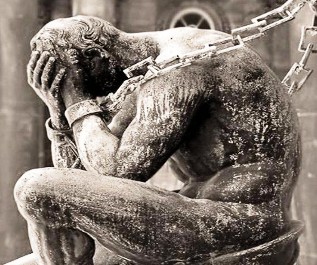
Slaves might be given an ear-ring so they could be controlled in much the same way as a nose-ring controls cattle today
But on the whole slaves seem to have been fairly well treated – they were valuable property, after all. The trusted slave was a man of very considerable importance and influence in the household – Joseph’s story, for example, shows this. There was nothing to prevent one born to the master by a slave girl from inheriting even the birthright.
There was provision for the release of Hebrew slaves, but not of foreign-born slaves, after six years of bondage. The slave could, however, contract to remain in bondage. If he did this willingly the lobe of his ear was pierced and he remained a slave for life. This law operated for men but not for women.
There is a gradual mellowing of the attitude to slaves, but it is not until Job 31: 13-15 that we find a real change, and some questioning of the moral justification for it.
Jesus and slavery
Jesus said nothing in criticism of the practice of slavery, but in the time of the early Church slavery began to be criticised, because many slaves had become Christian (Romans 16, 10; 1 Corinthians 1, 11), and Paul summed up all the conflicting ideas when he said that in Christ there is neither bond nor free (I Corinthians 12, 13).
When he persuaded Onesimus the runaway slave to return to his master Philemon (see above), he does not even suggest to Philemon that he should release Onesimus. In short, to the early Church, one’s position in society did not matter. This may have been partly due to their expectation of the imminent end of the age, and the second coming of Christ, but there must also have been the conviction that the important thing is not one’s standing in the eyes of society, but one’s standing in the eyes of God.
Saying of Jesus
‘No one can serve two masters; for a slave will either hate the one and love the other, or be devoted to the one and despise the other. You cannot serve God and wealth.’ (Matthew 6:24)
‘A disciple is not above the teacher, nor a slave above the master; it is enough for the disciple to be like the teacher, and the slave like the master.’ (Matthew 10:24)
‘You know that among the Gentiles those whom they recognize as their rulers lord it over them, and their great ones are tyrants over them. But it is not so among you; but whoever wishes to become great among you must be your servant, and whoever wishes to be first among you must be slave of all’. (Mark 10:42-44)
Bible Study activity
Slavery then and now: a debate
Topic: That wage slavery in the modern world is the same as slavery in past ages.
Divide into two sides.
Decide which side will support the proposal and which will oppose it.
In small groups on each side, draw up a list of at least three points to support your argument.
Share the points between groups, and decide which points should be argued most strongly.
Nominate the people who will speak, and a chairperson.
Team members meet and prepare their arguments.
Go over the rules for a debate, what may or may not be said and done.
Conduct the debate.
Hold a debriefing/discussion.
Save
‘Slave’ links
Who owned slaves?
How were they treated?
A talented slave like Joseph could rise high in the world
© Copyright 2006
Elizabeth Fletcher


